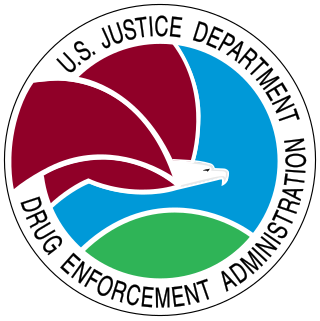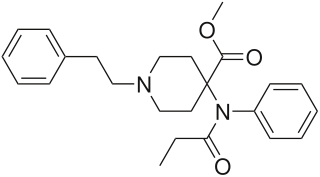Related Research Articles

Fentanyl, also spelled fentanil, is a highly potent synthetic opioid primarily used as an analgesic. Since 2018, fentanyl and its analogues have been responsible for most drug overdose deaths in the United States, causing over 71,238 deaths in 2021. Because fentanyl is 50 to 100 times more potent than morphine, its primary clinical utility is in pain management for cancer patients and those recovering from painful surgical operations. Fentanyl is also used as a sedative. Depending on the method of delivery, fentanyl can be very fast acting and ingesting a relatively small quantity can cause overdose. Fentanyl works by activating mu-opioid receptors. Fentanyl is also commonly known as fentanyl citrate, Sublimaze, Actiq, Duragesic, Fentora, and Matrifen.

The Drug Enforcement Administration is a United States federal law enforcement agency under the U.S. Department of Justice tasked with combating drug trafficking and distribution within the U.S. It is the lead agency for domestic enforcement of the Controlled Substances Act, sharing concurrent jurisdiction with the Federal Bureau of Investigation, the U.S. Immigration and Customs Enforcement, and U.S. Customs and Border Protection although the DEA has sole responsibility for coordinating and pursuing U.S. drug investigations both domestically and abroad. It was established in 1973 as part of the U.S. government's War on Drugs. The DEA has an intelligence unit that is also a member of the U.S. Intelligence Community. While the unit is part of the DEA chain-of-command, it also reports to the Director of National Intelligence. The DEA has been criticized for scheduling drugs that have medical uses, and for focusing on operations that allow it to seize money rather than those involving drugs that cause more harm.
Clandestine chemistry is chemistry carried out in secret, and particularly in illegal drug laboratories. Larger labs are usually run by gangs or organized crime intending to produce for distribution on the black market. Smaller labs can be run by individual chemists working clandestinely in order to synthesize smaller amounts of controlled substances or simply out of a hobbyist interest in chemistry, often because of the difficulty in ascertaining the purity of other, illegally synthesized drugs obtained on the black market. The term clandestine lab is generally used in any situation involving the production of illicit compounds, regardless of whether the facilities being used qualify as a true laboratory.

Carfentanil or carfentanyl, sold under the brand name Wildnil, is a very potent opioid analgesic which is used in veterinary medicine to anesthetize large animals such as elephants and rhinoceroses. It is typically administered in this context by tranquilizer dart. Carfentanil has also been used in humans for imaging of opioid receptors. It has additionally been used as a recreational drug, typically by injection, insufflation, or inhalation. Deaths have been reported in association with carfentanil.
Kolokol-1 is a synthetic opioid developed for use as an aerosolizable incapacitating agent. The exact chemical structure has not yet been revealed by the Russian government. It was originally thought by some sources to be a derivative of the potent opioid fentanyl, most probably 3-methylfentanyl dissolved in an inhalational anaesthetic as an organic solvent. However, independent analysis of residues on the Moscow theater hostage crisis hostages' clothing or in one hostage's urine found no fentanyl or 3-methylfentanyl. Two much more potent and shorter-acting agents, carfentanil and remifentanil, were found in the samples. They concluded that the agent used in the Moscow theater hostage crisis contained two fentanyl derivatives much stronger than fentanyl itself, sprayed in an aerosol mist.
The United States Drug Enforcement Administration (DEA) maintains lists regarding the classification of illicit drugs. It also maintains List I of chemicals and List II of chemicals, which contain chemicals that are used to manufacture the controlled substances/illicit drugs. The list is designated within the Controlled Substances Act but can be modified by the U.S. Attorney General as illegal manufacturing practices change.
A controlled substance is generally a drug or chemical whose manufacture, possession and use is regulated by a government, such as illicitly used drugs or prescription medications that are designated by law. Some treaties, notably the Single Convention on Narcotic Drugs, the Convention on Psychotropic Substances, and the United Nations Convention Against Illicit Traffic in Narcotic Drugs and Psychotropic Substances, provide internationally agreed-upon "schedules" of controlled substances, which have been incorporated into national laws; however, national laws usually significantly expand on these international conventions.

Janssen Pharmaceuticals is a pharmaceutical company headquartered in Beerse, Belgium, and wholly-owned by Johnson & Johnson. It was founded in 1953 by Paul Janssen.
The illegal drug trade in China is influenced by factors such as history, location, size, population, and current economic conditions. China has one-fifth of the world's population and a large and expanding economy. China's large land mass, close proximity to the Golden Triangle, Golden Crescent, and numerous coastal cities with large and modern port facilities make it an attractive transit center for drug traffickers. Opium has played an important role in the country's history since before the First and Second Opium Wars in the mid-19th century.

The Sinaloa Cartel, also known as the CDS, the Guzmán-Zambada Organization, the Pacific Cartel, the Federation and the Blood Alliance, is a large, international organized crime syndicate that specializes in illegal drug trafficking and money laundering. It was established in Mexico during the late 1980s as one of a various number of subordinate “plazas" operating under a predecessor organization known as the Guadalajara Cartel. It is currently headed by Ismael Zambada García and is based in the city of Culiacán, Sinaloa, with operations in many world regions but primarily in the Mexican states of Sinaloa, Baja California, Durango, Sonora, and Chihuahua. It also has a notable presence in a number of other regions in Latin America, such as Colombia; as well as in cities across the U.S. The United States Intelligence Community generally considers the Sinaloa Cartel to be the largest and most powerful drug trafficking organization in the world, making it perhaps even more influential and capable than Pablo Escobar’s infamous Medellín Cartel of Colombia was during its prime. It is also frequently referred to by other non-government based media sources as one of the most powerful and feared criminal organizations in the world and indisputably the most powerful in Mexico. During the leadership of Joaquín "El Chapo" Guzmán and Ismael Zambada García, the multi-billion dollar international drug trafficking empire supposedly controlled at least 91% of the world's heroin, methamphetamine, cocaine, and marijuana trade, regularly exporting multi-ton shipments of narcotics to the United States, Canada, Europe, Asia, Africa, and Australia. The organization has also been known to utilize narcosubmarines, boats, ships, trains, helicopters, and cargo planes for their smuggling operations. The Drug Enforcement Administration considers them to be "the biggest, most powerful drug cartel of all time".
Drug precursors, also referred to as precursor chemicals or simply precursors, are substances which are known to be used in the illegal manufacture of illicit drugs. Most precursors also have legitimate commercial uses and are legally used in a wide variety of industrial processes and consumer products, such as medicines, flavourings, and fragrances.

In the United States, the opioid epidemic is an extensive ongoing overuse of opioid medications, both from medical prescriptions and illegal sources. The epidemic began in the United States in the late 1990s, according to the Centers for Disease Control and Prevention (CDC), when opioids were increasingly prescribed for pain management, resulting in a rise in overall opioid use throughout subsequent years. The great majority of Americans who use prescription opioids do not believe that they are misusing them.

The COVID-19 pandemic, also known as the coronavirus pandemic, is an ongoing global pandemic of coronavirus disease 2019 (COVID-19) caused by severe acute respiratory syndrome coronavirus 2 (SARS-CoV-2). The novel virus was first identified in an outbreak in the Chinese city of Wuhan in December 2019. Attempts to contain it there failed, allowing the virus to spread to other areas of Asia and later worldwide. The World Health Organization (WHO) declared the outbreak a public health emergency of international concern on 30 January 2020, and a pandemic on 11 March 2020. As of 10 March 2023, the pandemic had caused more than 676 million cases and 6.88 million confirmed deaths, making it one of the deadliest in history.

Shortages related to the COVID-19 pandemic are pandemic-related disruptions to goods production and distribution, insufficient inventories, and disruptions to workplaces caused by infections and public policy.

The COVID-19 pandemic has had far-reaching economic consequences including the COVID-19 recession, the second largest global recession in recent history, decreased business in the services sector during the COVID-19 lockdowns, the 2020 stock market crash, which included the largest single-week stock market decline since the financial crisis of 2007–2008 and the impact of COVID-19 on financial markets, the 2021–2022 global supply chain crisis, the 2021–2022 inflation surge, shortages related to the COVID-19 pandemic including the 2020–present global chip shortage, panic buying, and price gouging. It led to governments providing an unprecedented amount of stimulus. The pandemic was also a factor in the 2021–2022 global energy crisis and 2022 food crises.

As of 11 January 2023, 12.7 billion COVID-19 vaccine doses have been administered worldwide, with 67.9 percent of the global population having received at least one dose. While 4.19 million vaccines were then being administered daily, only 22.3 percent of people in low-income countries had received at least a first vaccine by September 2022, according to official reports from national health agencies, which are collated by Our World in Data.

The 2020–present global chip shortage is an ongoing global crisis in which the demand for integrated circuits exceeds the supply, affecting more than 169 industries. The crisis has led to major price increases, shortages queues and reselling among consumers and manufacturers for automobiles, graphics cards, video game consoles, computers, household appliances, and other electronic products that require semiconductors.

The United States' response to the COVID-19 pandemic with consists of various measures by the medical community; the federal, state, and local governments; the military; and the private sector. The public response has been highly polarized, with partisan divides being observed and a number of concurrent protests and unrest complicating the response.
In 2021, as a consequence of the COVID-19 pandemic and the ongoing 2022 Russian invasion of Ukraine, global supply chains and shipments slowed, causing worldwide shortages and affecting consumer patterns. Causes of the economic slowdown included workers becoming sick with COVID-19 as well as mandates and restrictions affecting the availability of staff. In cargo shipping, goods remained at port due to staffing shortages.
References
- 1 2 WESTHOFF, BEN (18 August 2019). "The Brazen Way a Chinese Company Pumped Fentanyl Ingredients Into the U.S. Yuancheng used an army of young, perky salespeople to peddle illegal chemicals to Americans". The Atlantic. Retrieved 20 April 2020.
- ↑ WESTHOFF, BEN (6 September 2019). "Opinion: Trump wants China to rein in fentanyl producers. Good luck with that". LA Times. Retrieved 20 April 2020.
- ↑ "Testimony before the U.S.-China Economic and Security Review Commission "Exploring the Growing U.S. Reliance on China's Biotech and Pharmaceutical Products."" (PDF). USCC. 31 July 2019. Retrieved 20 April 2020.
- ↑ "Corona snijdt ook in het vlees van de drugsmaffia". DS Standaard. 11 April 2020. Retrieved 20 April 2020.
- ↑ Grierson, Jamie (12 April 2020). "Coronavirus triggers UK shortage of illicit drugs". The Guardian. Retrieved 20 April 2020.
- ↑ Vincent, Isabel (28 March 2020). "Coronavirus pandemic drives up price of heroin, meth and fentanyl". NY Post. Retrieved 20 April 2020.